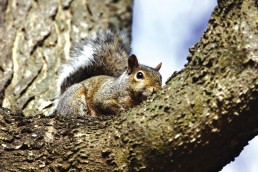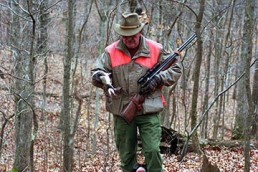Squirrels Kick off the Hunting Seasons
SHARE THIS POST
For over 50 years, squirrel hunting has meant a lot to me. Squirrels were the first things I ever hunted in the Shoal Creek Bottoms near Breese, Ill. That opened up a whole world of hunting for all kinds of critters on all kinds of terrain with many different weapons.
Squirrel is the first hunting season of the year, and by the time it rolls around I’m about ready to trade a rod in for my gun. I’ve never lost my love of squirrel hunting and appreciate this simple sport even more now.
It may still be hot during the opening month, but the mornings usually are cool enough to put me back in that special mode of going it alone through the hardwoods and hollows. The weight of a weapon over my shoulder brings back a lot of memories, and I kind of wish I could stay there forever. But during those 50-plus years, I haven’t missed a season and have learned a few things about stalking the squirrel using still-hunting.
For one, squirrels are smart, and much smarter than most people think. Scientists rank them among the 10 most intelligent animals in the world, right up there on the list with our beloved dogs, so they’re not as easy to bag as many think. And the wild ones in the woods are nothing like those semi-domesticated beggars in the city parks and homes.
Are you enjoying this post?
You can be among the first to get the latest info on where to go, what to use and how to use it!
In fact, it has been my contention for some time that if you’re a good squirrel hunter you can hunt anything in the woods: deer, turkey, etc. A successful squirrel hunter is a master woodsman.
Anybody can hunt them, and this is true because there are so many of them. But to hunt them well demands a high degree of skill in the woods. Stalking squirrels to within shotgun range is no easy task and requires patience, stealth and a good ear.
Following are some of the most important things I’ve learned from five decades of practicing this popular pastime:
- Move only a few steps at a time. Each time you take a step, don’t continue to scan the trees. Look at the ground to determine the best spot to place your foot. And when you set your foot down, do so with the heal first and the roll your foot forward. And don’t tiptoe.
- Pick a path that will make the least noise underfoot. I do not know of any studies to this effect, but I’m sure squirrels hear very well. Old deer trails and logging roads are ideal.
- Try to use the available brush to conceal your movements. Do not, however, go through it or move it aside with your hands. Shaking limbs or brush are sure giveaways. Duck under them or even crawl under them. Just don’t move them. Whenever possible, don’t stop in the open. Move from tree to tree and lean against them to break up your outline.
- Make all of your movements slow and deliberate. Don’t jerk your head or body around to check out noises, and don’t swing your gun barrel around as you shift its weight from arm to shoulder. A blued barrel is obvious when moved, especially when the sun is shining through the trees.
- Keep your ears open wider than your eyes. Listen for nuts falling, leaves rustling, claws on tree bark or teeth gnawing on a nut.
- Don’t leave a tree that you know a squirrel is in just because you can’t spot it readily. Like hunters, squirrels easily get bored with one spot, thinking another branch or even another tree offers better opportunities. When they finish with a cluster of nuts out on a limb they usually will follow that limb to the trunk, go up or down and out on another branch instead of just moving a few feet for another to feed. If you’re more patient than the squirrel, eventually you’ll get a shot.
- Each time you move, pause for a few minutes before moving again. I once wrote an article about the most successful squirrel hunters who participated in Missouri’s hunter survey. Every one of them, in one way or the other, said patience is the key. This applies equally whether you spend the entire hunt sitting under one hickory or moving through the woods.
While you’re practicing these tips, you will learn things about movement and body language and other factors that will help you later bag a turkey, down a deer or sneak up on an elk, let alone get your squirrel.
MWO
SHARE THIS POST
Did you enjoy this post?
You can be among the first to get the latest info on where to go, what to use and how to use it!
Ron Kruger
Ron Kruger has been communicating the outdoor experience for more than four decades. He has worked as a full-time guide for trout on the North Fork, for crappies and bass on Kentucky Lake and for smallmouths on the Current River. He has served as editor of three outdoor magazines, and owns a patent on a fly/lure called the Desperate Diver.



